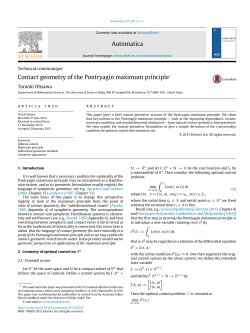
2.1 Hamiltonian Circuits
Chapter 2: Business Efficiency This chapter deals with the concept of saving time and money in traversing a circuit that only needs to visit each vertex once, rather than traversing every edge once, such as checking storm sewers, traffic signals, or mail dropboxes. An efficient tour of the graph would be a route that started and ended at the same vertex and passed through all the vertices without reuse, or repetition. We start in section 2.1 with a discussion of Hamiltonian Circuits. A tour that starts at a vertex of a graph and visits each vertex once and only once, returning to where it started, is called a Hamiltonian circuit. The Hamiltonian circuit is named for the Irish mathematician William Rowan Hamilton, who lived in the 1800's. The concepts of Euler and Hamilton are similar in that both forbid reuse. An Euler circuit forbids the reuse of edges, while the Hamiltonian circuit forbids the reuse of vertices. There is no simple method for telling whether or not a graph has a Hamiltonian circuit. Some special cases of graphs are known to have them, while others are known not to have them. 1 In situations where the number of vertices is small, it is fairly easy to determine whether or not a Hamiltonian circuit exists, and if it does, to find it, such as in the following examples: 1) 2) 2 Some types of graphs which do not have Hamiltonian circuits are the following: 1) if we have two columns of vertices, one having more vertices than the other, there will not be a Hamiltonian circuit. 2) in the case of the 4by4 grid below, there is no Hamiltonian circuit. Going from one vertex to another, notice that we must alternate colors. Thus there would need to be the same number of each color vertex, but there is not. Hence, there is no Hamiltonian circuit. 1) 2) Q: If the number of vertices in the columns were the same, could the graph have a Hamiltonian circuit? Q: Could a 3-by-3 grid have a Hamiltonian circuit? 3 Another type of graph where there is not a Hamiltonian circuit is a graph that has two parts connected by one edge or one vertex, such as the following: Q: Does either graph above have an Euler circuit? Also, any graph which has a vertex of valence 1 cannot have a Hamiltonian circuit, such as the following: 4 Determine whether or not each graph has a Hamiltonian circuit. If it does, state the circuit. No No 5 No Yes; one Hamiltonian circuit is shown. Yes; one Hamiltonian circuit would be ADBECFA. Yes; one Hamiltonian circuit is shown. 6 One major application of Hamiltonian circuits is in vacation or trip planning, as seen in Example 1 (p. 37). Another application would be in package or express mail delivery. A student studying in Chicago (C) plans a spring break trip to visit friends in Minneapolis (M), Cleveland (CL), and St. Louis (S). There are many choices of routes, but you want the most efficient (shortest distance) route to save time and gas money. You create the following graph, which has the destination cities as vertices, the routes between them as the edges, and the mileage shown between each pair of cities. To find the minimumcost Hamiltonian circuit, we use the following algorithm (stepbystep process): 1) Generate all possible Hamiltonian circuits (starting at Chicago (C)). 2) Add up the distances on each tour. 3) Choose the tour that gives the smallest total distance. C To determine the possible circuits, we can use the method of trees, as follows: 7 The previous example made the method of trees seem very straightforward, but if the number of vertices was much larger, the tree method would be rather unwieldy, so we need a simpler method for finding the number of circuits. First, we need the definition of a complete graph. A graph is called complete if there is exactly one edge between each pair of vertices in the graph. We can determine the number of Hamiltonian circuits a complete graph with n vertices has by using the same type of analysis that we used in the method of trees, which is a visual application of the fundamental principle of counting. Consider the previous example, where the number of destinations from Chicago was three. From each of those three cities, the number of destinations was two. And from each of those two destinations, we had only one choice left. That means that in a complete graph with four vertices, there were 3x2x1 or 6 possibilities, but remember that only half of them were distinct, so there were actually only 3 distinct circuits. Using a similar argument for a complete graph with five vertices, the number of distinct Hamiltonian circuits should be (4x3x2x1)/2 or 24/2 or 12. So if there are 7 vertices, it would be (6x5x4x3x2x1)/2. The notation for multiplying a number (say 6) by each whole number smaller than it is called 6 factorial and is denoted 6! So, following this logic, the number of distinct Hamiltonian circuits in a complete graph with n vertices would be (n 1)!/2. The method of finding all of these circuits and determining the minimum cost circuit is called the brute force method. 8 Find the minimumcost Hamiltonian circuit using the bruteforce method, starting at city A and traveling to cities B, C, and D. 7 A 8 D B 14 13 18 10 C 9 10
© Copyright 2025










